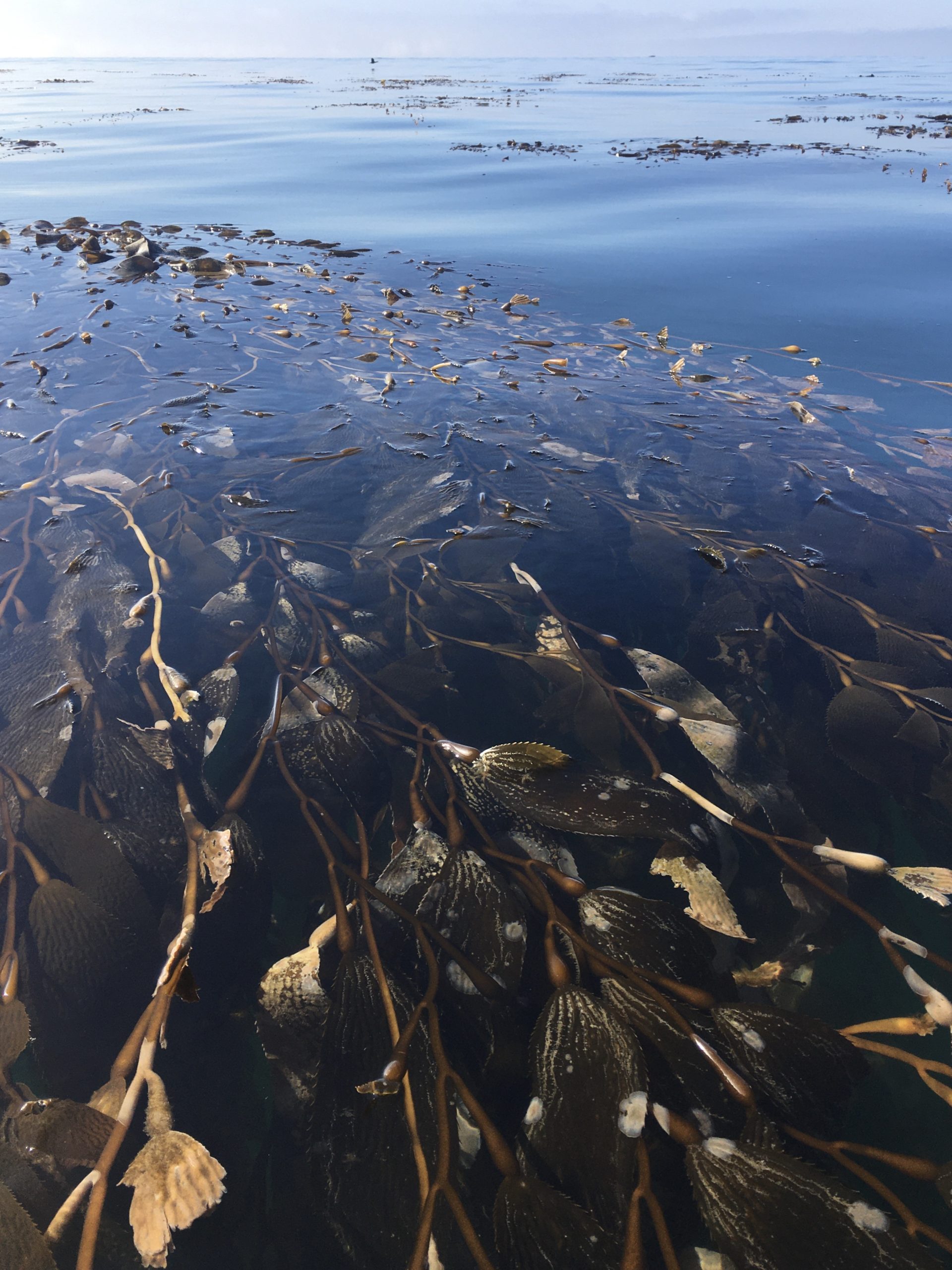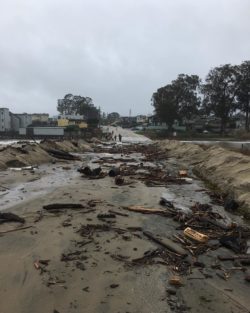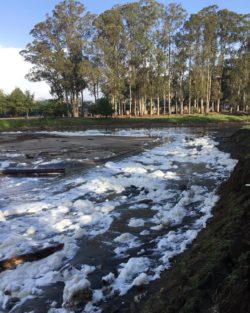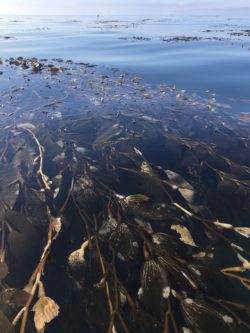
Blog: “You can help our marine sanctuary, and its iconic kelp forests, fight climate change” By: Dan Haifley
You can help our marine sanctuary, and its iconic kelp forests, fight climate change.
With climate change in the spotlight thanks to the January 2023 storms, I’m reminded of the important work happening at the Monterey Bay National Marine Sanctuary, part of a national network of protected areas that fight climate change and pollution and protect biodiversity. That includes preserving iconic kelp forests which reduce coastal erosion and absorb excess carbon from climate change.
————————————————-
The punishing storms of January 2023 invoke memories of events in 1982 that damaged our coastline, flooded streets and structures, and unleashed deadly mudslides. Today much more than 40 years ago, we are also talking about how climate change is a factor.

East Cliff Drive at Cororan Lagoon, January 13, 2023
According to the USGS, “With increasing global surface temperatures the possibility of more droughts and increased intensity of storms will likely occur. As more water vapor is evaporated into the atmosphere it becomes fuel for more powerful storms to develop. More heat in the atmosphere and warmer ocean surface temperatures can lead to increased wind speeds in tropical storms. Rising sea levels expose higher locations not usually subjected to the power of the sea and to the erosive forces of waves and currents.”
Much of the activity this time was generated by winds and powerful ocean swells that devastated piers, caused waterways to spill over into low lying areas, and ripped up infrastructure and eroded cliffs, including on West Cliff Drive. In another example, at Moran Lake County Park the sea overtook the tiny pocket beach, East Cliff Drive, and a paved walkway. Seawater rushed through the culvert and over the road, creating a new beach inside the lagoon on the other side.

Moran Lake, January 9, 2023
There are two ways to discuss climate change; the first about reducing the greenhouse gasses we send into the atmosphere, and the second about adapting ourselves and our built environment to the inevitable impacts that are both coming and already here.
Among the many tools available to us now to help reduce greenhouse gas emissions and to adapt to climate change are a healthy ocean and wetlands, which include the United States’ network of marine sanctuaries and marine national monuments.
These 17 protected areas, in US waters and the Great Lakes, have researchers addressing these issues. That, of course, includes Monterey Bay National Marine Sanctuary.
Protecting the California current
Monterey Bay National Marine Sanctuary’s professional team conducts research, education, and resource protection for productive waters that support habitats for species including blue whales, California sea otters, birds, invertebrates, deep sea creatures, and fishes.
Its 6,094 square miles include the Monterey Submarine Canyon that plunges 11,800 feet deep off Moss Landing, and Davidson Seamount, added in 2008, whose 7,500-foot-high summit is 4,000 feet below the surface, 75 miles west of San Simeon.
And it’s not the only sanctuary.
Waters from Point Arena in Mendocino County down to Cambria in northern San Luis Obispo County are currently protected by Greater Farallones, Cordell Bank, and Monterey Bay National Marine Sanctuaries. Channel Islands National Marine Sanctuary protects its namesake islands, though there is offshore oil development nearby in the Santa Barbara Channel.
Tribally nominated Chumash Heritage National Marine Sanctuary, if designated, would fill the gap between those sanctuaries between northern San Luis Obispo and the Channel Islands, providing an unbroken chain of protection along much of the California Current; the productive waters off the west coast that host a rich array of wildlife, including the Alaska to Baja California migration route for the iconic California gray whale, and the range for the California sea otter.
Building ocean resilience
The ocean covers more than two thirds of the earth, produces half the world’s oxygen produced by plankton, absorbs excess atmospheric carbon and supplies food. But it is also under increasing stress.
National marine sanctuaries and marine national monuments covering 620,000 square miles in a system established 50 years ago support the ocean by protecting marine life and ecosystems, conducting research, educating the public, and preserving native Indigenous sites and shipwrecks. The number of protected areas and associated programs is poised to expand, thanks in part to the efforts of the National Marine Sanctuary Foundation, of which we are a chapter.
While the ocean is impacted by climate change, it is also our planet’s main defense against it. Documented impacts of climate change include sea level rise, stronger storms, and rising ocean temperatures. These affect coastal erosion rates, infrastructure damage, biodiversity and weather patterns.
The ocean buffers impacts originating from human generated greenhouse gasses by absorbing atmospheric CO2. However, this process leads to ocean acidification, as the pH in ocean water decreases, impacting things like oyster aquaculture and food availability for salmon.
Marine sanctuaries enable scientists, conservationists, and resource managers to combat the effects of climate change through restoration projects and resilience provided by healthy ecosystems, while safeguarding natural abilities of the ocean to absorb carbon. For example, UCSC scientists have received two research grants from NOAA to study impacts on marine life, and improve adaptation to them, in California’s national marine sanctuaries.
Monterey Bay National Marine Sanctuary’s team and their partners have also been conducting research, including an effort to restore marshes, coordinating planning on coastal sediment management; measuring trends and impacts of oceanographic data on temperature, pH and oxygen levels; providing data to shipping and aquaculture businesses, and planning for other mitigation impacts on particularly sensitive species.
The deep sea off the California coast is naturally one of the most acidic areas of the ocean. Large and spectacular deep-sea corals are the likely “canaries in the coal mine” for impacts of ocean acidification. The Monterey Bay Aquarium Research Institute and Monterey Bay National Marine Sanctuary have teamed up to develop a deep-sea coral observatory on Sur Ridge, southwest of Monterey Bay, to study ways to restore deep sea corals there, southwest of Monterey Bay which are part of the sea’s ability to absorb carbon but would be affected by ocean acidification. Lessons learned from this research have developed deep-sea coral restoration techniques for damaged ecosystems and are building our understanding of carbon sequestration in this highly biodiverse ecosystem.
Kelp defends against climate change
The Monterey Bay Chapter of the National Marine Sanctuary Foundation is raising funds for an effort to protect and restore our kelp forests, which provide habitat for the California sea otter, rockfish, crabs and numerous other species. It is referred to as the Iconic Kelp project.
Robust kelp forests will help us adapt to climate change as their canopies dampen waves protecting shorelines from erosion, while absorbing CO2 through photosynthesis to reduce our contribution to greenhouse gas emissions. Some kelp is naturally deposited into the deep sea.

Kelp off Moran Lake Beach, July 30, 2022
Scientists have been monitoring the status of kelp forests since 1984, providing a historic basis for understanding how they respond to stressors such as changes in temperature, and informing future work in restoration and supporting healthy ecosystems in various stages of development.
The idea for the comprehensive kelp plan is being developed by the sanctuary’s research advisory panel with input from the public through the sanctuary advisory council. This is being done in concert with the state of California and non-governmental groups like the Monterey Bay Aquarium.
The first step will be a workshop with scientists and experts to lay out the path to success. The project will be in addition to a team of volunteer divers who are now working off the Monterey Peninsula to restore kelp forests by reducing the population of voracious urchins, which feed on kelp.
The Iconic Kelp project will be one more tool in the effort to fight, and adapt to the impacts of, climate change. For example, the County of Santa Cruz has obtained funds to increase the wetland habitat values at the lagoon at Moran Lake County Park, where recent storms sent seawater and created a new beach. Projects like these can, working together, have an impact.
Your financial support of the Iconic Kelp project will make a difference. To stay informed, and get involved, go to https://montereybay.noaa.gov/ , montereybayfoundation.org, and follow Monterey Bay National Marine Sanctuary and the Monterey Bay Chapter of the National Marine Sanctuary Foundation on Facebook, Twitter, and Instagram. You’ll be glad you did.
The author gratefully acknowledges the contributions of Monterey Bay National Marine Sanctuary Research Coordinator Dr. Andrew DeVogelaere to this article.
Dan Haifley was founding director of O’Neill Sea Odyssey and Save Our Shores and serves on the Monterey Bay National Marine Sanctuary Foundation board. He can be reached at dan.haifley@gmail.com
